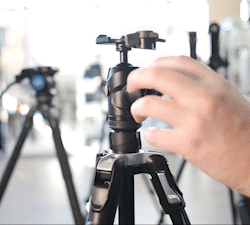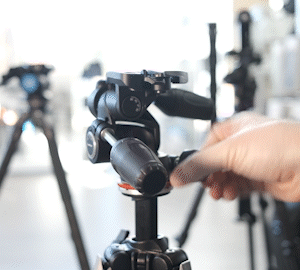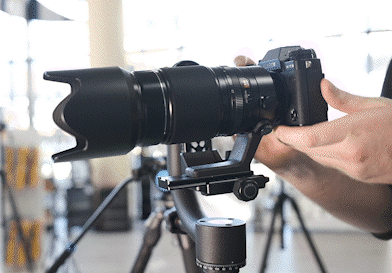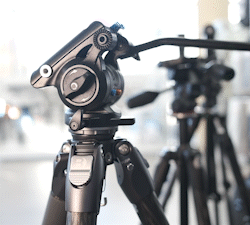Tripod Heads
Give Your Camera the Support It Needs
Even the highest quality camera using the newest technology can't digitally compensate for every movement made by a swaying arm or natural handshake. This is where tripods and tripod heads come into play. What was once just a stable appendage for your equipment to sit on has now evolved to give many options to your exact style of movement and orientation needed to get the shot.
Types of Tripod Heads
With the improvements in camera quality, the possibilities of what could be captured facilitated the need to stabilize shots in all environments. Depending on your needs, each tripod head has something to offer. To find the best one though, we'll need to dive into each option and how they operate.
Ball Heads

Definitely sitting at the throne of "most popular" tripod heads, ball heads utilize a machined bearing with a camera mount attached to them. This allows for full rotation as it does away with extra arms and axis-based construction that can hinder movement.
The rise to fame is thanks to the simplicity of its design. A screw sits on the outside to tighten the ball bearing in place once you have it correctly positioned.
Simply loosen, rotate, tighten and you've got an entirely new shot.
The downside is that minor adjustments can be hard to do as a fully loosened ball will move extremely easily, but too tight and your small nudge will cause you to set up the shot again. That being said, the adaptability of a ball head makes it useful for almost any application, though some shots will demand a more bespoke option.
Pan & Tilt / 3-Way

The industry standard and traditional tripod head is the 3-way, named after the ability to independently move along three axes with the control arms that lock it in place. These are commonly seen used in professional settings where precision outweighs convenience.
The ability to lock each axis in place once it's correctly positioned makes precise adjustments easier to do on the fly without starting from scratch.
Much like the ball head, each control arm extruding from the tripod head is tightened and loosened to hold its respective section in place. Higher-end models even have additional settings for macro adjustments done on heavily zoomed-in shots.
This extreme level of detail and adjustment is why the 3-way tripod head still rivals the universal ball head in many applications. The bulkier size can be a challenge for action shots, where stopping to set up isn't an ideal scenario. Landscapes, architecture and studio-quality still shots are where the 3-way tripod heads really shine.
Pistol Grip
Favoured heavily for those taking action shots, the pistol grip is a variation of the ball head. Instead of utilizing a screw on the side of the bearing, there is a constant pressure placed on it that is released when you squeeze the trigger.
This quick change between shots is ideal for trips through nature to capture wildlife as well as sports shots that need frequent panning and zooming to get the perfect action shot. Mini pistol grips are also commonly used as an alternative to a full-sized tripod since the grip naturally sits in your hand, lending itself to truly be a point and shoot option for stabilizing.
These are also favoured by those wanting to place binoculars or spotting scopes on tripods as the adjustment mechanism is further away from where the mounting bracket is located on other tripod heads, allowing for easier working areas.
Geared
Coming down the line from a 3-way head is the geared head. It uses the same axes for movement and positioning with the difference coming in the engineering. Instead of being tracks with tightened screws holding it in place, the control arms are directly tied to the mechanism meaning as you twist it the camera moves.
This high level of detail in movement makes it ideal for extremely fine adjustments where precision is the primary focus. The slow speed of the control arms can make this a painfully slow option for fast-paced environments but makes it ideal for architects or any extreme precision stitching photography, the need the exact framing for documentation and detailed reporting.
Gimbal

Gimbal heads are where we start getting into the more specialty items. Used for cameras with large lenses, the gimbal heads are much bulkier and sturdier to protect your equipment. This attachment also changes the rotation point, instead, it attaches to the tripod as an extension of it with the actual mount being connected to the head directly.
This lets photographers with heavy equipment track easily without needing to compensate manually making extremely high-quality wildlife and sports shots possible. That being said, those looking for general tripods should steer clear as gimbal heads are highly specialized.
Fluid/Video

Fluid heads depart from photography use case for the main reason of losing an axis of movement. but behave differently to the above gimbal head.
It can pan and tilt, but not rotate at an angle for portrait orientation. Rather than being open or closed for movement, you can adjust the friction to allow for more consistent repositioning. This means tracking in videos is a simple as grabbing the control arm and following the target with a 'fluid' motion.
This is a heavy video focus tripod head and could lend itself to an entire article about the variations within this category. (stay tuned)
Start Supporting Your Camera Today
Every photographer should support support, meaning putting in the extra effort to get that perfect shot each time. While there are many options on the market today, they can typically be used for general applications.
One final thing to note when looking at these tripod head categories is that within each category is a whole world of further options, sizes and specific designs. If you are concerned that a 3 way head is too bulky for travel, Manfrotto recently released a compact collapsable 3-way head. If you want the pan options on a ball head, Leofoto and Benro both make amazing panoramic ball heads. The main thing to work out is what your main focus will be with photography and buy accordingly. Similar to lenses, you can't have the perfect lens that does it al, though some will come pretty close.
Ball heads will give you the most freedom for fast adjustments or general shots while on the go. 3-way heads find more home in static shots with their bulkier but more stable engineering. If you love a huge lens, your gimbal will be your best friend while videographers or photographers dabbling in video will find that fluid heads make the entire process smoother.
The key here is to think about your ideal type of shot and get the matching head to start. You can also grab an entry-level piece from each style to find the best fit from there. You really can't go wrong with a tripod head as each one is an improvement over holding it by hand.


